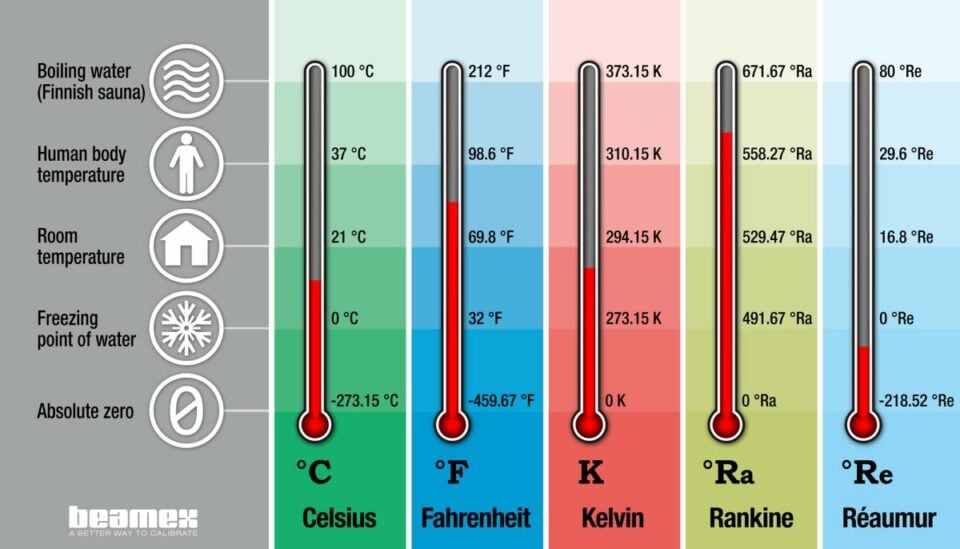Subscribe to our monthly newsletter to get notified about any new tools or educational content
- Choose the sensor type from the list of thermocouples and RTDs
- Select temperature unit
- Select conversion direction (Electrical > Temperature, or Temperature > Electrical)
- Enter input value
- Read output value
You can download a CSV sensor table by selecting table step size and clicking the “Export CSV” button.
Temperature sensor calculator
Temperature calibration articles
View all our calculators
Frequently asked questions
The calculator is utilizing the source code that is used in Beamex MC6 family of calibrators.
The Platinum RTD sensors (RTD, Ptxxx) calculations are based on the IEC 60751 standard.
Thermocouple calculations are based on IEC 60584-1 standard.
An RTD (Resistance Temperature Detector) is a temperature sensor that measures temperature by correlating the resistance of the sensor element with temperature. Typically made of pure platinum, RTDs are known for their high accuracy, stability, and linear response over a wide temperature range. They are widely used in industrial and scientific applications where precise and reliable temperature measurement is critical. Unlike thermocouples, RTDs require an electrical current to pass through the element to measure the resistance, which changes with temperature.
A Pt100 sensor is a type of RTD (Resistance Temperature Detector) that uses platinum to measure temperature. The “100” refers to the sensor having a resistance of 100 ohms at 0°C. Pt100 sensors are highly accurate, stable, and provide a linear response over a broad temperature range, making them ideal for precise temperature measurements in industrial and laboratory settings. They are widely used due to their reliability and consistency in converting temperature changes into electrical signals.
Read more on Pt100 sensors here: https://blog.beamex.com/pt100-temperature-sensor
The “alpha” coefficient in RTD sensors, typically denoted as α, represents the rate of change of resistance with temperature. It defines how much the resistance of the RTD changes per degree Celsius and is crucial for determining the sensor’s accuracy. The most common value for platinum RTDs, like Pt100, is 0.00385 Ω/Ω/°C (shortened to 385 in calculator), based on the ITS-90 standard. This coefficient ensures that RTDs provide consistent and precise temperature readings across their operational range. Variations in alpha indicate different RTD standards and affect the sensor’s calibration.
A thermocouple is a temperature sensor that measures temperature using the Seebeck effect, which occurs when two different metals are joined at one end, creating a voltage that changes with temperature. Thermocouples are known for their wide temperature range, durability, and fast response times, making them ideal for various industrial and scientific applications. They are commonly used in environments where high temperatures and harsh conditions are present, such as in furnaces, engines, and other high-heat processes.
Read more on thermocouples and Cold Junction here: https://blog.beamex.com/thermocouple-cold-junction-compensation
To calibrate a temperature sensor, immerse it in a known temperature environment created using a temperature source, such as a liquid bath or a dry-block. For best accuracy, the true temperature can be measured with a calibrated reference sensor placed alongside the sensor being calibrated. For example, a stirred ice bath can provide a precise 0°C (32°F) point. Professional calibration often involves using programmable temperature baths or dry-blocks to set accurate temperature points.
Read more here: https://blog.beamex.com/how-to-calibrate-temperature-sensors
You can use this tool as either a Pt100 calculator or an RTD calculator. The resistance of Pt100 and other RTD sensors changes with temperature. This calculator allows you to convert a resistance value into a temperature value, or a temperature value into a resistance value.
You can use this tool as a thermocouple calculator. The voltage signal of a thermocouple changes with temperature. This calculator enables you to convert a voltage value into a temperature value, or a temperature value into a voltage value.


















